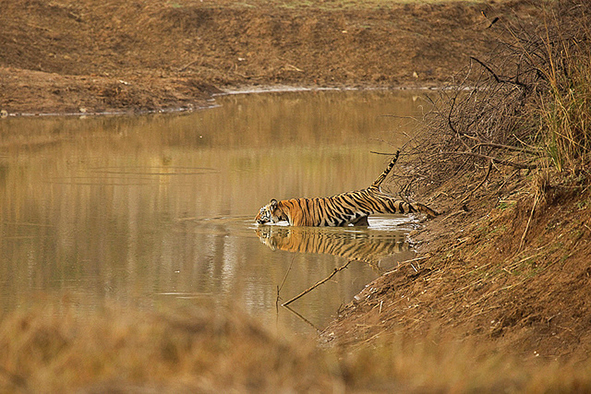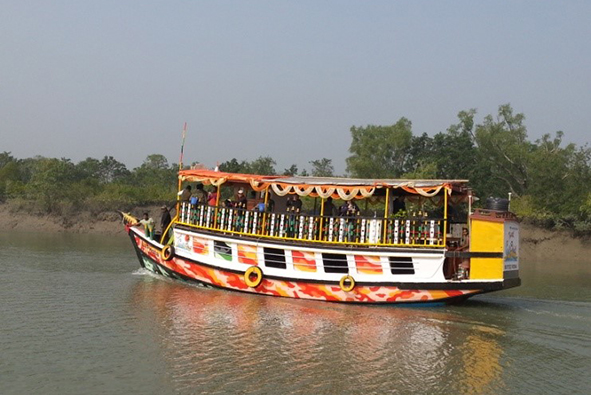“Tiger! Tiger! Burning bright, in the forests of the night, what immortal hand or eye, Could frame thy fearful symmetry?” William Blake’s immortal lines resonated through my mind as we sailed through the dark, swampy jungle searching for the elusive Royal Bengal tiger.

A Royal Bengal tiger taking a dip (Photo: Rohit Varma via Flickr)
I woke up in the Sundarbans to the call of the rooster and an orchestra of quacking, chirping and bleating outside. Stepping out onto the little bamboo bridge in front of my mud hut, I found myself surrounded by coconut and banyan trees. Nearby, a flock of lambs congregated by a line of thatched roof huts cuddled by small, sleepy looking ponds with paddling of ducks and geese. In the misty morning, the Eco-Village seemed idyllic.
I was on the island of Satjelia, one of the 54 tiny islands in the saline mud flat mangrove delta, intertwined by innumerable tributaries of the Ganges. Satjelia, within the Indian Territory, is close to the core reserve and National Park area of the Sundarbans and home to the largest remaining population of the critically endangered Royal Bengal tiger. Although enveloped by the serene tranquility of the village, I was aware of the wild terrain I was in. It was only few years ago that a hungry tigress had sneaked into Satjelia, striking terror in the hearts of the villagers as she roamed the fields and preyed on the cattle for almost a week before she was captured by the Forest Department.
Village Life in the Sundarbans
I walked past the green pastures and the paddy fields watching the villagers go about their daily lives and quaint rituals. A man was thrashing cotton to stuff inside a quilt, another knitted a mosquito net and a woman wove a basket while some children frolicked in the pond. One of the boys smiled at me and said “look what I have here sister” and proudly brandished in his hand what looked like a water snake.
The Sundarbans is a complex estuarine and intertidal region located at the mouths of the Ganges, Brahmaputra and Meghna rivers between India and Bangladesh on the Bay of Bengal. It has rich bio-diversity with many species of flora and fauna, including snakes such as python, king cobra and Russell’s viper. The National Park also has other famous reptiles like monitor lizards and olive ridley sea turtles. But the most dreaded of all the reptiles in the swampy delta is the crocodile.
A cute little lamb curiously followed me down the narrow meandering dirt path to the river bed where local tradesmen were clambering onto a ferry boat carrying their baskets and crates full of goods. I found two men huddled together, deep in conversation sitting by the river smoking their bidis. The smoke from their bidis mingled with the mist rising from the river. A large fishing net lay next to them. I sat down beside them and enquired “Brother, where are these traders going?” One of them replied “just across to Gosaba island for the morning haat”. Gosaba is the last inhabited island towards the core park area. It is also a vibrant village with lodges and hotels and the largest market, or haat, in the area. Tourists arriving from Kolkata by road 82km away would normally alight at Godkhali ferry ghat, the last road point to catch a ferry to Gosaba.

Royal Bengal Tiger, Sundarbans (Photo: Dibyendu Ash via WikiCommons)
Most villagers depend on honey and wood, collected from the deep interiors of the jungle, and fishing for crabs and lobsters for their livelihood. The tide is unpredictable. The sea level, rising with the effects of global warming, encroaches on the villages inch by inch each year. Honey collecting and fishing in the mudflats with tigers, crocodiles and poisonous snakes is perilous. Collection of forest products is subject to permits and strictly regulated. Yet, many venture into the protected and forbidden areas anyway to fish or collect honey, wearing human masks with big eyes painted at the back of their heads as they believe tigers attack mostly from behind.
Those few that have lived to tell the tale of an encounter with the mighty cat only remember the piercing dark eyes of the tiger. The tiger is known to be able to carry a grown cow between its teeth and over a fence. Locals view the tiger as a ‘man eater’ and local legends say that there were once so many casualties that one of the villages was named ‘Vidhwa Palli’ or Widow Village. They fear to mention the tiger by name as to use its name would be akin to beckoning it. Instead, they call it ‘Mama’ or ‘Uncle’. Living in awe and fear of the tiger is the way of life in the Sundarbans.
Climatic changes and rises in the salinity of the water in recent times has started destroying the mangrove vegetation on which many species, such as deer depend. Falls in the deer population, the main source of food for tigers, in turn forces them to venture into human habitations in search of food. Striking a delicate balance between ensuring sustainable livelihoods for the human population and conservation and protection of the ecology and wildlife is at the centre of the enhanced efforts of the National Forest Department and international organisations such as the WWF.
Bird Watching

Bird watching by boat (Photo: Subarna Ganguly)
Just before sunset, our Tour de Sundarbans guide took us bird watching on board a small wooden boat, a must do while in the Sundarbans. We glided through labyrinths of small creeks while Ajay pointed out the various birds to us. Sundarbans is home to seven types of Kingfisher, brahminy kites, pond herons and many others.
Ajay explained to us the origin of the word ‘Sundarbans’. The word in Bengali means ‘A beautiful forest’ (Sundor=beautiful, Bon=Forest) and also comes from ‘Sundari’, an exquisite local variety of mangrove tree that grows in the jungle. The main feature of the Sundari tree is that it produces spikey roots that grow above the ground. During the rainy season when the entire forest is water logged, the breathing roots help in the respiration process in these brackish waters. These rare plants also offer a natural protection from tidal surges, damage by wave and storm erosion, and minimize the effects of typhoons and hurricanes on human settlements. When the 2004 tsunami ravaged the coastal regions of India, the mangroves broke the impact, acting as a natural shield.
As I was admiring the unique, thorny roots that jutted out from the muddy river bed, a heron flew over my head and dived into the water to catch its prey. It was very therapeutic watching the sunset over the horizon while the breeze gently caressed my face and we snaked in and out of the swampy rivulets.
We took a rickety old thela-gadi, a sort of hybrid between a rickshaw and a cart back to the Eco-village. I hopped onto the back and the cart driver peddled away furiously over the bumpy village road. Chickens scuttled past and little kids waved at us as we raced along. The rest of the evening was magical. Sitting on carpets on the ground, engulfed in the silence of the jungle, under a starry sky with the moon shining bright in the pollution-free sky, we enjoyed the homely food prepared by the villagers and listened to local musicians. Their soulful voices filled the air and our hearts.
The Jungle Safari

A Jungle boat (Photo: Subarna Ganguly)
We set off early atop Elmar, our safari boat for the day. It was a beautifully decorated two storied open engine boat with rugs and benches on the top floor and a kitchen on the bottom floor. Colourful jungle boats such as Elmar are the only mode of transportation to the core interiors of the Sundarbans: the last remaining expanse of the majestic jungles that once covered the Gangetic plains. Today it spans an area of 10,000km2 with 4,000km2 lying in Indian territory and the remainder in Bangladesh. It is the world’s largest mangrove delta and a UNESCO heritage site. The safari lasted from sunrise to sunset and we sailed through the channels and creeks, breathing in the pure air, traversing through the dense jungle, on the lookout for tigers and other exotic wildlife.

Cruising the Sundurbans (Photo: Stephen White via Flickr)
Our boat chugged along, deeper into the jungle. I felt excited and nervous at the prospect of seeing a tiger any second and scanned the forest for any signs of movement. With every rustle of leaves, my heart skipped a beat. I asked our guide Ajay “can the tiger leap onto the boat?” he replied, “yes, they are great swimmers and can jump to great heights”. Seeing the dreaded look on my face, he hastily added, “don’t worry, the tiger never attacks tourist boats, the engine noise scares them away. They fear us more than we fear them”. That may be true as only few are lucky enough to see a tiger during a safari. They can mostly be spotted swimming across the river or when they come to quench their thirst at one of the sweet water ponds near the watch towers.
We made a few stops at the watch towers of Dobanki, Sajnekhali and Sundhanykhali. They are maintained by the Forest Department which also carries out a regular tiger census using camera tapping technology. According to the 2015 census, there are currently 74 tigers on the Indian side and 106 on the Bangladesh side. These numbers are considerably less than the last estimate and wildlife conservationists are deeply concerned that the declining trend could soon lead to the national animal of both India and Bangladesh becoming extinct in the wild. Poaching, loss of habitat and bitter man-animal conflict pose the greatest threats to it.
This sensitive region supporting an exceptional level of biodiversity is itself under threat from climate change and deforestation. Although I didn’t see the magnificent tiger during our jungle safari, seeing fresh pug marks by the river bed was quite thrilling. We were more than compensated by all the other equally fascinating wildlife we sighted such as deer, crocodiles, civets, leopards and the endangered Ganges River dolphins.
As the sun set over the water where various tributaries of the main rivers converged, our boat turned around to take us back to civilization. The wild beauty of the Sundarbans was undoubtedly captivating but what I gained most from my experience was a deep respect for the dogged resilience of this unique ecosystem where the mangroves, man and wildlife fight hard for survival, against all odds.